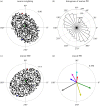Modularity speeds up motor learning by overcoming mechanical bias in musculoskeletal geometry
- PMID: 30305418
- PMCID: PMC6228487
- DOI: 10.1098/rsif.2018.0249
Modularity speeds up motor learning by overcoming mechanical bias in musculoskeletal geometry
Abstract
We can easily learn and perform a variety of movements that fundamentally require complex neuromuscular control. Many empirical findings have demonstrated that a wide range of complex muscle activation patterns could be well captured by the combination of a few functional modules, the so-called muscle synergies. Modularity represented by muscle synergies would simplify the control of a redundant neuromuscular system. However, how the reduction of neuromuscular redundancy through a modular controller contributes to sensorimotor learning remains unclear. To clarify such roles, we constructed a simple neural network model of the motor control system that included three intermediate layers representing neurons in the primary motor cortex, spinal interneurons organized into modules and motoneurons controlling upper-arm muscles. After a model learning period to generate the desired shoulder and/or elbow joint torques, we compared the adaptation to a novel rotational perturbation between modular and non-modular models. A series of simulations demonstrated that the modules reduced the effect of the bias in the distribution of muscle pulling directions, as well as in the distribution of torques associated with individual cortical neurons, which led to a more rapid adaptation to multi-directional force generation. These results suggest that modularity is crucial not only for reducing musculoskeletal redundancy but also for overcoming mechanical bias due to the musculoskeletal geometry allowing for faster adaptation to certain external environments.
Keywords: muscle synergies; musculoskeletal system; neural network model; primary motor cortex; upper-limb muscles.
© 2018 The Author(s).
Conflict of interest statement
The authors declare no competing interests.
Figures






 ). The two red lines denote the major and minor axes of the bimodal distribution, the length of which corresponded to the eigenvalues of the variance–covariance matrix of the distribution. (b) Total error between the input and output torques across each trial during the rotational period. Averaged learning speed across each target for 30 sets of iterations during the rotational period is also drawn in polar coordinates. The direction in the polar coordinates corresponds to those in figure 1b. Data are shown across the four different biases of the distribution: blue,
). The two red lines denote the major and minor axes of the bimodal distribution, the length of which corresponded to the eigenvalues of the variance–covariance matrix of the distribution. (b) Total error between the input and output torques across each trial during the rotational period. Averaged learning speed across each target for 30 sets of iterations during the rotational period is also drawn in polar coordinates. The direction in the polar coordinates corresponds to those in figure 1b. Data are shown across the four different biases of the distribution: blue,  ; red,
; red,  ; green,
; green,  and cyan,
and cyan,  . (c) Total neuron activations across each trial during the rotational period. The origin of the right plot across each series of plots (b,c) corresponds to the end of the left plot. (d) Averaged learning speed for 30 sets of iterations. Error bars denote the standard deviation. (e) Averaged total error at the end of the rotational period for 30 sets of iterations. *p < 0.001.
. (c) Total neuron activations across each trial during the rotational period. The origin of the right plot across each series of plots (b,c) corresponds to the end of the left plot. (d) Averaged learning speed for 30 sets of iterations. Error bars denote the standard deviation. (e) Averaged total error at the end of the rotational period for 30 sets of iterations. *p < 0.001.

References
-
- Bernstein N. 1967. The coordination and regulation of movements. New York, NY: Pergamon Press.
Publication types
MeSH terms
LinkOut - more resources
Full Text Sources
Other Literature Sources
